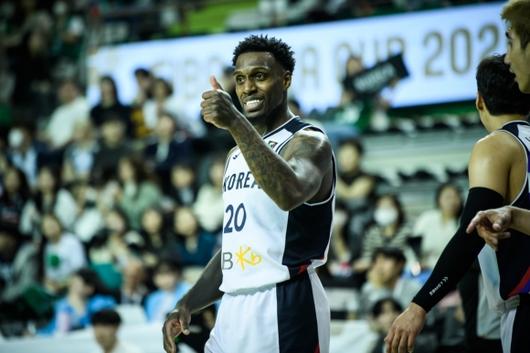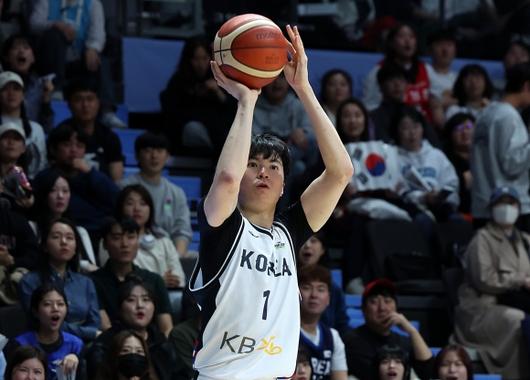The Korean basketball team has entered a transitional period. The bottom line has been weakened by the absence of La Gun-ah, whose special naturalization contract has ended, but there is no strategy or tactic in sight to make up for this. In order to compensate for his low height and weak strength, he must find a solution in the fast attack and on the outside. The key is how to use Lee Hyun-joong (Illawarra), who can attack with his personal abilities.
As of the 25th, the national team led by coach Ahn Jun-ho ranked second in Group A (2 wins, 2 losses) of the 2025 International Basketball Federation (FIBA) Asia Cup group stage. They defeated Thailand (88th) and Indonesia (77th), which are lower than Korea in the FIBA rankings (53rd), in succession, but suffered two losses to Australia (7th). The two-game home game held at Sono Arena in Goyang this month also ended with 1 win and 1 loss.
Looking at the game against Australia the previous day, they were pushed both inside and outside with 9-16 3-pointers and 37-47 rebounds. On the 21st, against Indonesia, which was one level below, they had a 50-32 rebound lead, but were inferior in 3-point shots (9-12). As a result, the team was pushed back until the middle of the fourth quarter, and faced the risk of becoming a victim of an upset. Korea struggled as the movements of the guard and wing resources overlapped when the big man caught the ball, handed it off, or set a screen. It didn’t look like the team was able to breathe quickly or properly.
After losing 75-98 to Australia, Coach Ahn emphasized the need for naturalized players, saying, “There is an urgent need to reinforce height.” However, considering the administrative power of the Korea Basketball Association and the complex special naturalization procedures, the likelihood of this happening quickly is slim. Therefore, finding realistic solutions within available resources is an urgent priority. First of all, quick attacks are important. Looking at this national team’s roster, wingmen with both speed and height, such as Ahn Young-jun (Seoul SK) and Lee Woo-seok (Ulsan Hyundai Mobis), were active. If they run while rebounding and the big man takes charge of the trailer, they can be a useful offensive option. The team’s power is expected to double when key centers such as Kim Jong-gyu (Wonju DB) and Ha Yoon-ki (Suwon KT), who were out due to knee injuries, return. A representative example is SK. SK ranked first in the domestic league (8 wins, 2 losses) with a fast attack that sent more than one player to the opponent’s half before even getting a defensive rebound.
The second is an outside attack. Yoo Sang-sang (Changwon LG) proved his skills as a shooter by hitting three 3-pointers with a 42.9% success rate in the game against Indonesia. Lee Woo-seok and Byun Jun-hyung (Anyang Cheongkwanjang) also combined for five 3-point shots in the game against Australia. Lee Jeong-hyeon (Goyang Sono) is also scheduled to return in the two-game series between Thailand and Indonesia in February next year.
The key is Lee Hyun-joong’s role. In his comeback after three years, Lee Hyun-joong focused on filling the void left by big men such as Kim Jong-gyu and Ha Yoon-ki. He grabbed an average of 10 rebounds in two games, but only made 1 out of 15 3-point shots. Lee Hyun-joong said, “During this time, Geon-ah’s presence was great. “Now, all players have to participate in the rebound and then make a fast attack,” he said. “I was also in charge of grabbing the rebound and hitting the ball. “It’s still in the process of getting better,” he said. We need to make use of the defensive skills of Oh Jae-hyeon (SK) and Yu Ki-sang to make up for our height weakness. A coach of a professional club said, “There were players like Oh Jae-hyun and Yoo Yu-sang who were strong in advanced defense, but it is unfortunate that they were not able to take advantage of this. “If Lee Jeong-hyun returns, we can strengthen the front line pressure,” he said. “(Lee) Hyun-joong is very motivated to do well.” “The more we work together, the better our performance will be,” he said.
Reporter Seo Jin-sol
– Copyright ⓒ Seoul Newspaper –
The categories of this article follow the classification of media outlets.
The category an article belongs to is classified by the media company.
News organizations can classify an article into two or more categories.

**Beyond simply finding a replacement for La Gun-ah’s height, what strategic adjustments could the Korean national team make to their playing style to be more competitive against taller opponents?**
This article highlights the challenges the Korean national basketball team faces after the departure of La Gun-ah and proposes potential solutions. Here are some open-ended discussion questions based on the article:
**The Challenge of Height Disadvantage:**
* The article mentions the need for “height reinforcement.” Does this necessarily mean finding another naturalized player? What other strategic options could the team explore to overcome its height disadvantage?
* How can the team utilize its existing players’ strengths (speed, wingspan, defensive skills) to compensate for its lack of height?
**The Importance of Fast Attacks and Outside Shooting:**
* How can the team effectively implement a fast-paced offensive strategy? What specific tactics can they use?
* The article mentions several players with strong outside shooting abilities. How can the team ensure consistency from beyond the arc?
**Lee Hyun-joong’s Role:**
* What are the expectations for Lee Hyun-joong as he returns to the national team?
* How can the team best utilize his talents and experience to address the team’s weaknesses?
**Team Dynamics and Development:**
* What role will the returning injured players (Kim Jong-gyu, Ha Yoon-ki, Lee Jeong-hyeon) play in strengthening the team?
* The article mentions the need for players to “work together.” How important is team cohesion and chemistry for the team’s success?
**Looking Ahead:**
* What are the realistic goals for the Korean national team in the upcoming FIBA Asia Cup qualifications and beyond?
* How can the team build on its experience and develop into a more competitive force on the international stage?
By discussing these open-ended questions, you can encourage a deeper understanding of the challenges facing the Korean national basketball team, explore potential solutions, and spark debate about the future of the sport in Korea.


![Generative AI market ‘two-strong structure’ reorganized… MS·OpenAI vs Amazon·Anthropic [AI브리핑] Generative AI market ‘two-strong structure’ reorganized… MS·OpenAI vs Amazon·Anthropic [AI브리핑]](https://img.lb.inews24.com/v1/facebookexternalhit/face/626x352/772e76de3c6d1b.jpg)
![“‘Dysplasia’, a pre-cervical cancer stage, continues to increase… “HPV vaccination is important.” [건강+] “‘Dysplasia’, a pre-cervical cancer stage, continues to increase… “HPV vaccination is important.” [건강+]](https://img.segye.com/content/image/2024/11/25/20241125516554.jpg)